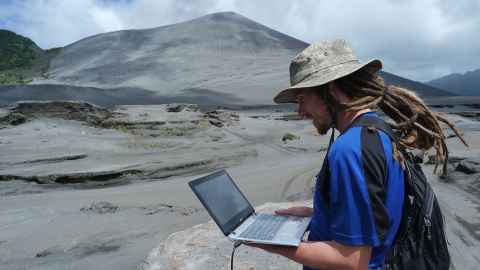Volcano research may safeguard communities
8 March 2018
Opinion: Ben Simons (Environment) talks about the passion of volcanologists worldwide, the annual #VolcanoCup and his research on constantly active Mt Yasur in Vanuatu.

There is a vibrant global community of volcanologists who are keen to share their love of volcanoes, their knowledge of geology and anything else that they may just think is cool about their work.
Twitter has become a natural habitat, more so than other social media platforms, for scientists who are increasingly interested in communicating their research to the wider public. The volcano ‘World Cup’ running under the hashtag #VolcanoCup is an excellent example of real time sharing of scientific fervour. This knock-out-style tournament pitted volcano against volcano, with volcanologists battling it out for votes from the twitter geoscience community and the greater public.
After a series of rounds featuring competition from the famous and powerful including Vesuvius, Etna and Mt St Helens, the final of this year’s Volcano Cup saw our own mighty Taupo pitted against Indonesia’s Krakatau. A strong cohort of New Zealand volcanologists and loyal supporters rallied around Taupo, but Krakatau won on the day and our North Island landmark was knocked into second place.
Although Taupo Caldera was a great contender for #VolcanoCup champion, having produced some of the largest eruptions on Earth in the last ~30,000 years, my own favourite in was Yasur, a small cone located on Tanna, a rural island of 25,000 inhabitants in the southern end of the Vanuatu Archipelago. Unfortunately, Yasur was knocked out in the early rounds by the eventual winner.
What makes Yasur so fascinating is that it is a persistently active volcano, one of only a handful on the planet. These volcanoes exist in a near-continuous state of eruption. It is believed that eruptions at Yasur have continued without significant pause for the last 1,500 years. It is also one of the most frequently erupting volcanoes on Earth, with explosions occurring almost every minute from a number of summit vents. These ‘Strombolian’-style explosions violently eject a mixture of hot volcanic gasses, ash and lava fragments up to 500 metres into the air at speeds exceeding 400 metres per second.
These volcanoes exist in a near-continuous state of eruption. It is believed that eruptions at Yasur have continued without significant pause for the last 1,500 years.
The regular display of spectacular showers of hot lava, as well as easy access to the summit, has turned Yasur into one of the most important tourist destinations of the Republic of Vanuatu with visitor numbers steadily climbing.
The surrounds of the volcano are heavily populated with rural Ni-Vanuatu communities who can become normalised to the regular volcanic activity, being hit unprepared when potential sudden upsurges in volcanism occur. Further for Tanna Island, where volcanic tourism has become a major revenue source, any upsurges can have serious implications for the local economy.
For these reasons, it is important to get a clear understanding of the natural variability of these volcanoes and understand the processes that control both the style and the power of eruptive activity. With my research I hope to bring together an understanding of the deep internal dynamics with shallow-level processes that control explosive eruption behaviour at Yasur. The ultimate goal being to identify potential precursory signals that may herald periods of heighted volcanic activity. The results of this research will hopefully aid the local community build resilience to the negative effects of the volcano, as well as provide important knowledge to the agencies charged with keeping safe the many visitors that gather at the summit each night.
My research has taken me to Vanuatu many times over the last three years, with the main body of research comprising a three-month period of uninterrupted monitoring at the summit of Yasur. During this time we ran our own small-scale volcanic observatory and lived right at the base of Yasur which meant we accessed the volcano almost every day. We deployed multiple instruments and collection techniques including thermal cameras, sulphur dioxide spectrometers and an array of seismometers aimed at evaluating the relationships between gas output, magma eruption rate, explosion energy, and hazard potential.
One of the perks of working on one of the world’s most active volcanoes is the sheer number of explosions that you get to witness, an estimated ~20,000 in my case. I have also been lucky enough to see a number of spectacular volcanic phenomenon up-close such as volcanic lightning, blast waves and gas (smoke)-rings.
Being able to work in such close proximity to constant volcanic activity increases our ability to understand how volcanoes work, which in turn increases our chances of helping communities living alongside volcanic threats to protect their families, their homes and their livelihoods.
You can follow Benjamin's research via his Twitter account @dread_rocks.
Benjamin Simons is a doctoral candidate in The School of Environment at the University of Auckland’s Faculty of Science.
This article reflects the opinion of the author and not the views of the University of Auckland.
Used with permission from Newsroom, Volcano research may safeguard communities published on 8 March 2018.